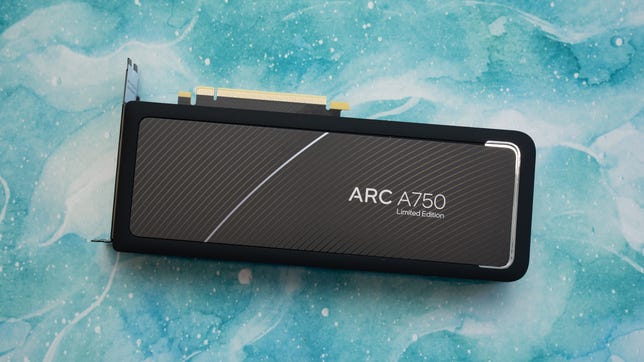Technologies
Intel Arc A750 LE Graphics Card Review: A Sub-$300 Speed Champ
But it doesn’t score quite as high on stability.
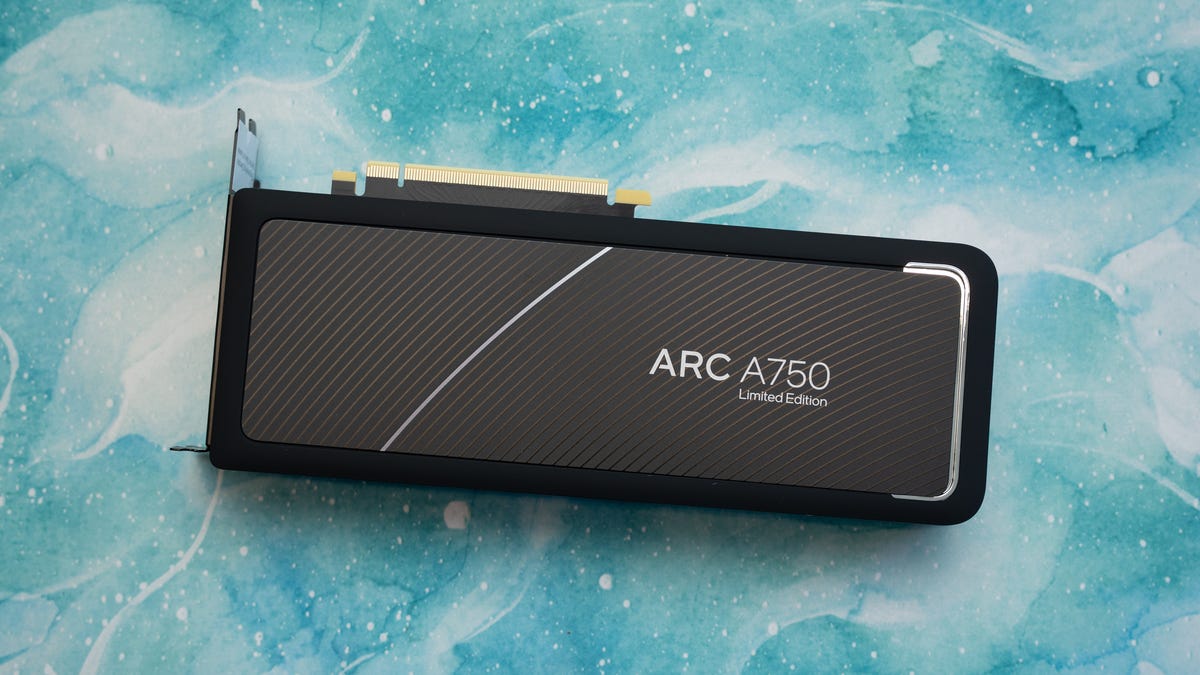
Intel came very (very) late to the party with its desktop graphics cards, so it’s not surprising that they feel like a bit of a work in progress compared to veterans like Nvidia and AMD.
From a price and specs perspective, the A750 competes with Nvidia’s budget GeForce RTX 3050, which also falls roughly into the $250 to $300 price band. Intel dropped the price from $300 to $250 in February, but the market doesn’t seem to have totally caught up with that yet.
Like
- Good price for its performance
- AV1 encoding support
Don’t Like
- Experienced some instability
- large for its performance class
The Arc line currently includes a sub-$150 8GB entry-level Arc A380 and upmarket A770, which comes in two flavors: an Intel Limited Edition, with 16GB VRAM, and one available through board partners such as ASRock and Acer. The latter cards have bulked-up specs, notably four additional Xe graphics cores and faster clock speeds. So for less memory-demanding 1080p gaming the 8GB A770 might provide a little lift over the A750 — but it may not be worth the extra cash, depending on what they’re going for at any moment.
I’m not convinced the 16GB version makes a lot of sense. If you need that much memory, say for video editing or 1440p-plus gaming, you’re going to want more powerful components.
Intel Arc A750 Limited Edition
| Intel Arc A750 Limited Edition | |
|---|---|
| Memory | 8GB GDDR6 |
| Memory bandwidth (GBps) | 512.0 |
| Memory clock (GHz) | 2.0 |
| GPU clock (GHz, base/boost) | 2.1/2.4 |
| Memory data rate/Interface | 16Gbps/256 bits |
| Render Slices/RT cores | 4/28 |
| Texture mapping units | 224 |
| Tensor Cores | 448 |
| Process | 6nm |
| TGP/min PSU | 225/600W |
| Max thermal (degrees) | 194F/90C |
| Bus | PCIe 4.0×16 |
| Size | 2 slots; 11.1 inches long (282mm) |
| Connections | 3 x DP 1.4, 1 x HDMI 2.0 |
| Current list price | $249 |
| Ship date | October, 2022 |
You can get surprisingly reasonable 1440p performance out of the A750, especially if you’re aggressive with XeSS (Xe SuperSampling), the company’s upscaling technology a la Nvidia’s DLSS or AMD’s FidelityFX Super Resolution.
Keep in mind that if you’re upgrading an old system you may not get claimed (or as tested) performance. And by «old» I mean pre-2020 or earlier than Intel’s 10th-gen and AMD’s Zen 3 desktop CPUs. That’s because best performance requires resizable BAR support, which lets the CPU store its game-related data in the GPU’s VRAM rather than system RAM so the GPU doesn’t have to traverse the system bus to retrieve it. But the same RBAR performance caveat applies to most recent GPUs.
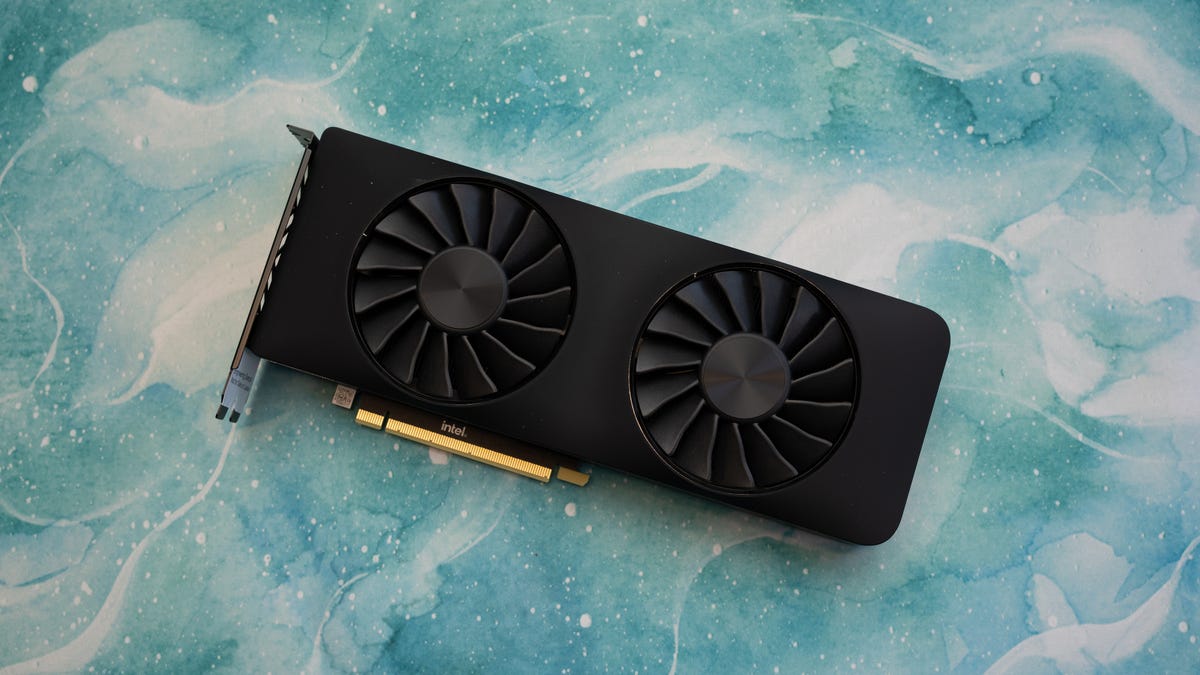

The A750 LE is a full-length card.
Lori Grunin/CNETThe visible design aspects are pretty typical for a GPU: two fans on one side, vents on top and bottom and out the end. It’s heavy for its class, but there’s a lot of metal and thick, sturdy plastic. You can add a waterblock, though I could only find a couple compatible ones, one of which costs as much as the card. And removing the backplate can potentially get ugly, since it’s glued rather than screwed on. (I didn’t disassemble mine, but TechPowerUp has a nice teardown of it.)
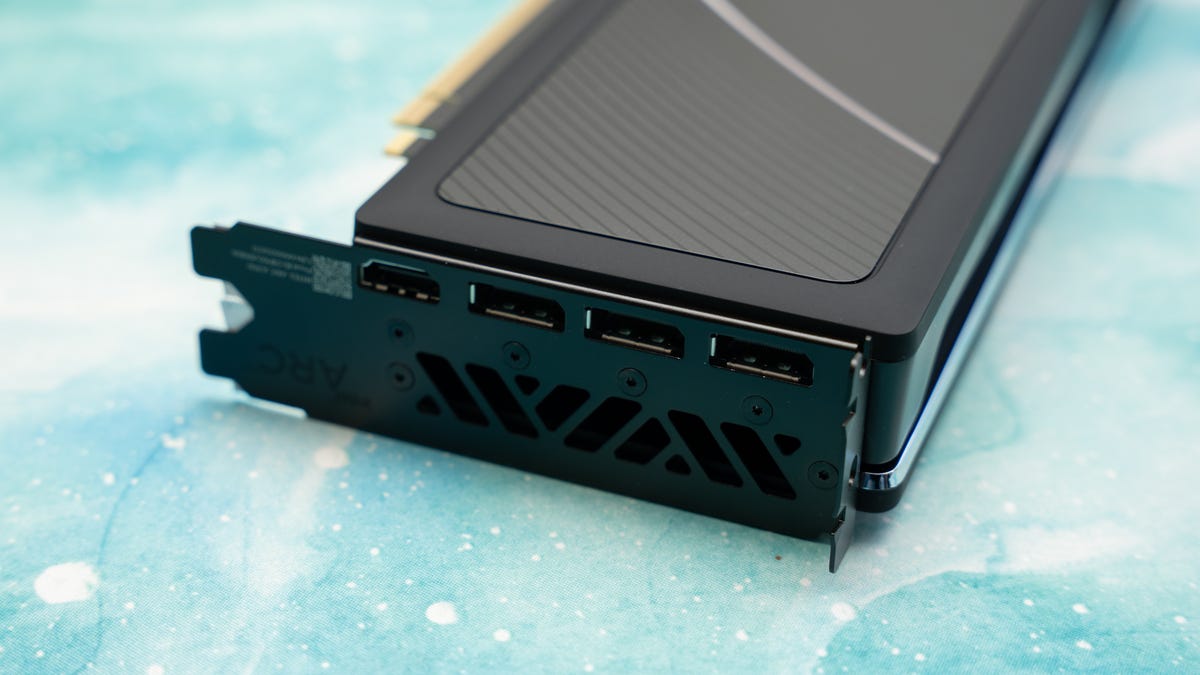

The A750 takes up two slots.
Lori Grunin/CNETPerformance
I’ve compared the A750 to the RTX 3060, since the EVGA RTX 3050 I reviewed is no longer produced — the company left the business in September 2022. The Asus Dual RTX 3060 OC is more expensive by about $100, but isn’t always the faster card. And even where the A750 lags it, for 1080p gaming it doesn’t do so by much. The RTX 3060’s 12GB of VRAM helps when you bump up resolution or do graphics work, but the newer architecture of the A750 means it acquits itself better than the two-year-old 3060 on operations like ray tracing. And because it’s not an old entry GPU, it supports AV1 encoding (for better streaming performance), while other low-end — Nvidia and AMD’s entry- and midlevel GPUs are still based on last-gen architecture.
My biggest gripe about the A750’s performance, though, isn’t about frame rates, it’s about the driver and related software. Some conflict with my network card — an Intel Wi-Fi 6E AX211 — made my system report it as having failed in Event Viewer, despite all indications to the contrary. It was still operational, though. But I never would have seen those event reports had I not been trying to track down the cause of freezes/BSODs. Removing the card and uninstalling the driver restored stability. Could be correlation, not causation, but I haven’t seen a BSOD in a long time.
Intel also configures its Arc Control Utility’s default well below the card’s stated maximum power consumption — 190 watts vs. 228 watts — which makes sense. For one thing, I saw only about a 4% frame-rate increase bumping it to 215 watts. But it also runs hot once you start playing with the overclocking settings, easily hitting its 90C maximum (and slightly above), and definitely hot enough to start exhibiting display glitches.
Overclocking anything runs the risk of system instability, but Arc Control doesn’t make it easy (or less tedious) to iterate through the possibilities.
These kinds of issues are normal for early generations of GPU technologies, and Arc is just a baby, which makes it a hard call against veteran competitors. But if you want something fast for less than $300, the Arc A750 is an attractive proposition. Just keep in mind you may have to change some GPU diapers.
Relative performance of comparable GPUs
Shadow of the Tomb Raider gaming test (1080p)
Note:
Longer bars indicate better performance (FPS)
Guardians of the Galaxy (1440p)
Note:
Longer bars indicate better performance (FPS)
3DMark Time Spy
Note:
Longer bars indicate better performance
3DMark Speed Way (DX12 Ultimate)
Note:
Longer bars indicate better performance
SpecViewPerf 2020 SolidWorks (1080p)
Note:
Longer bars indicate better performance (FPS)
3DMark DXR (DirectX Ray Tracing)
Note:
Longer bars indicate better performance (FPS)
Test PC configuration
| Custom PC | Microsoft Windows 11 Pro (22H2); 3.2GHz Intel Core i9-12900K; 32GB DDR5-4800; 2x Corsair MP600 Pro SSD; Corsair HX1200 80 Plus Platinum PSU, MSI MPG Z690 Force Wi-Fi motherboard, Corsair 4000D Airflow midtower case |
|---|
Technologies
Today’s NYT Strands Hints, Answers and Help for Nov. 27 #634
Here are hints and answers for the NYT Strands puzzle for Nov. 27, No. 634.
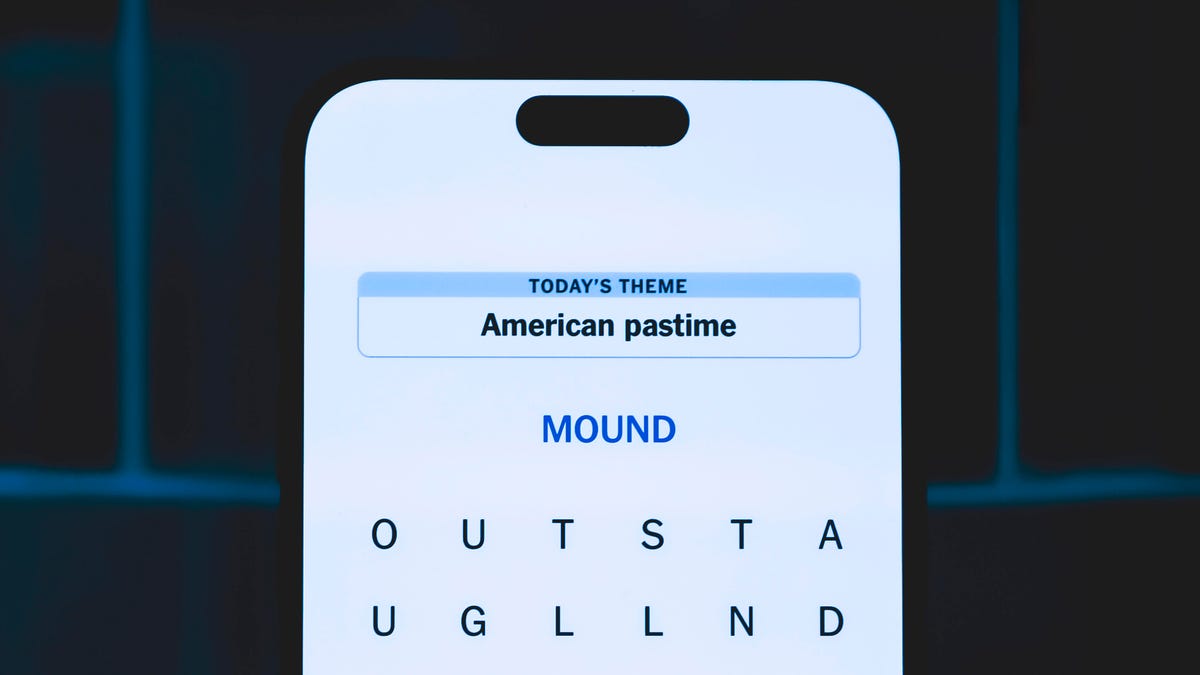
Looking for the most recent Strands answer? Click here for our daily Strands hints, as well as our daily answers and hints for The New York Times Mini Crossword, Wordle, Connections and Connections: Sports Edition puzzles.
Today’s NYT Strands puzzle has a holiday theme. Some of the answers are difficult to unscramble, so if you need hints and answers, read on.
I go into depth about the rules for Strands in this story.
If you’re looking for today’s Wordle, Connections and Mini Crossword answers, you can visit CNET’s NYT puzzle hints page.
Read more: NYT Connections Turns 1: These Are the 5 Toughest Puzzles So Far
Hint for today’s Strands puzzle
Today’s Strands theme is: With gratitude.
If that doesn’t help you, here’s a clue: Today’s the day.
Clue words to unlock in-game hints
Your goal is to find hidden words that fit the puzzle’s theme. If you’re stuck, find any words you can. Every time you find three words of four letters or more, Strands will reveal one of the theme words. These are the words I used to get those hints but any words of four or more letters that you find will work:
- MALE, MALES, DIAL, THEY, HONK, WRIT, ENDS, HEAL
Answers for today’s Strands puzzle
These are the answers that tie into the theme. The goal of the puzzle is to find them all, including the spangram, a theme word that reaches from one side of the puzzle to the other. When you have all of them (I originally thought there were always eight but learned that the number can vary), every letter on the board will be used. Here are the nonspangram answers:
- FOOD, LIFE, FAMILY, FRIENDS, HEALTH, WORK, COMMUNITY
Today’s Strands spangram
Today’s Strands spangram is THANKFUL. To find it, start with the T that’s five letters down on the far-left row, and wind up and across.
Toughest Strands puzzles
Here are some of the Strands topics I’ve found to be the toughest in recent weeks.
#1: Dated slang, Jan. 21. Maybe you didn’t even use this lingo when it was cool. Toughest word: PHAT.
#2: Thar she blows! Jan.15. I guess marine biologists might ace this one. Toughest word: BALEEN or RIGHT.
#3: Off the hook, Jan. 9. Similar to the Jan. 15 puzzle in that it helps to know a lot about sea creatures. Sorry, Charlie. Toughest word: BIGEYE or SKIPJACK.
Technologies
Google’s Pixel Buds Pro 2 Just Hit a New Low of $134 in Amazon’s Black Friday Sale
We’ve never seen these earbuds fall this low, but we don’t expect this deal to last for long.
If you’re in the market for a new pair of earbuds this Black Friday, now’s your chance to get them. We’ve found a great discount on the Google Pixel Buds Pro 2 thanks to the Cyber Week festivities. They’re among the best wireless earbuds as our top pick for Android users and, at just $134, they’re a bargain to boot.
That’s a new low for these earbuds, but do be aware that it only applies to the moonstone color currently. That could change at any moment, though, so make sure to check the price of the other colors if moonstone isn’t your thing. Either way, we don’t expect this price to last for long, so order sooner rather than later.
The earbuds provide noticeably improved sound quality and noise cancellation compared to their predecessor. They’re built with Google’s powerful Tensor A1 chip and designed to offer rich, immersive sound. It’s the first time a Google Tensor chip has been featured in any earbuds and the result is robust active noise cancellation and advanced sound.
The Google Pixel Buds Pro 2 earbuds deliver deep bass with their built-in 11 mm drivers and a new high-frequency chamber for smoother treble. CNET’s audio expert David Carnoy noted that compared to the original Pixel Buds Pro, «there’s more depth and richness to the sound with better overall definition and extension.» Read his full review of the Pixel Buds Pro 2 to get the full lowdown.
These buds also got a design upgrade, with Google making them 27% smaller and 24% lighter to securely fit even more ear types. If you want to wear them during workouts, there’s a twist-to-adjust stabilizer to help lock your earbuds in place while you’re moving around and sweating.
There’s also a conversation detection feature that pauses your music and switches your earbuds to the transparency mode if you start talking. And with an impressive 30-hour battery life, you can listen to all your favorite songs, audiobooks and podcasts for hours on end without having to recharge.
HEADPHONE DEALS OF THE WEEK
-
$248 (save $152)
-
$170 (save $181)
-
$298 (save $131)
-
$199 (save $150)
Why this deal matters
At $134, these earbuds are a great buy thanks to advanced active noise cancellation, impressive sound quality and a lengthy battery life. The current deal makes the Pixel Buds Pro 2 earbuds cheaper than ever. But the deal won’t be around for long, so act fast if you want to take advantage of this awesome discount.
Join Our Daily Deals Text Group!
Get hand-picked deals from CNET shopping experts straight to your phone.
By signing up, you confirm you are 16+ and agree to receive recurring marketing messages at the phone number provided. Consent is not a condition of purchase. Reply STOP to unsubscribe. Msg & data rates may apply. View our Privacy Policy and Terms of Use.
Technologies
Apple Desperately Needs to Launch a Foldable iPhone Flip Next Year
Commentary: Apple is the only major phone company without a folding phone. That needs to change in 2026.
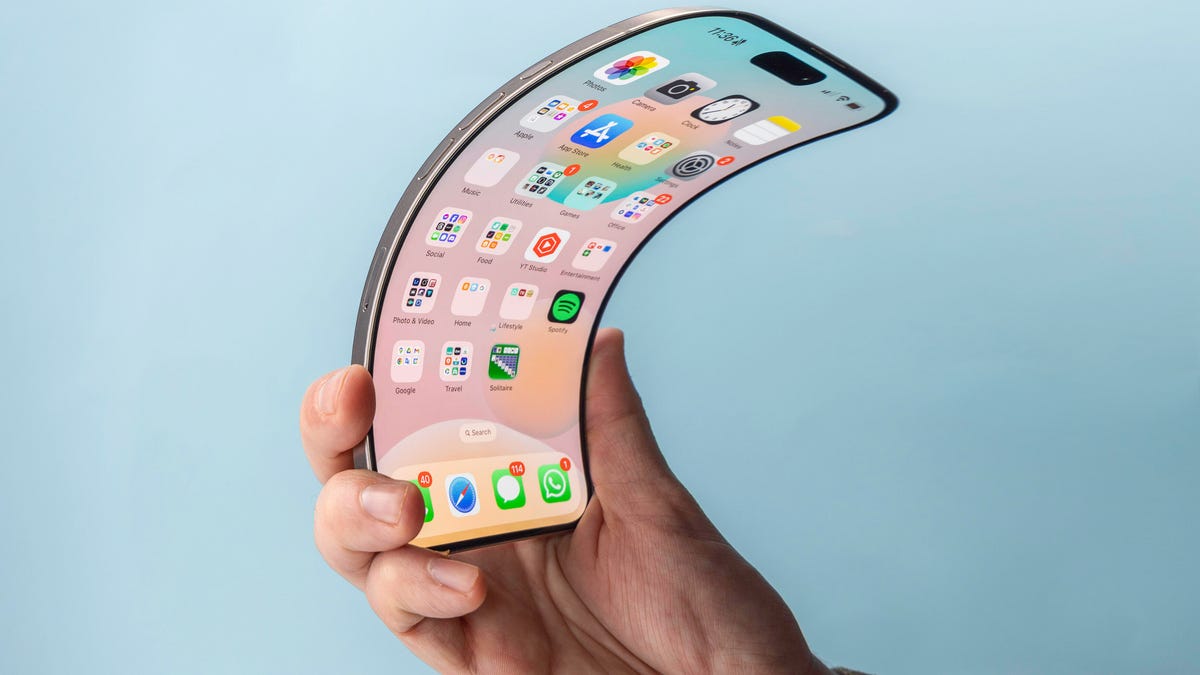
Apple’s iPhone 17 came and went and while we certainly love the iPhone 17 Pro and its vibrant cosmic orange color, I can’t help but be disappointed that the long-rumored foldable iPhone Flip wasn’t part of the company’s September launch event. Most Android phone-makers, including Samsung, Google, Motorola, OnePlus, Xiaomi and Honor are multiple generations into their own folding phone lineups, and it’s beginning to feel like Apple is late to the party. That might be a problem.
Apple dominates in the premium phone category, but foldables — which fit into the premium space in terms of price — are already nipping at its heels, with Motorola telling CNET that 20% of customers buying its Razr foldable jumped ship from Apple. Meanwhile, Samsung is in the seventh generation of its Flip and Fold series. As Lisa Eadicicco discovered during a visit to Seoul, «foldables are everywhere» in Samsung’s home country of South Korea.
With nearly every major Android phone-maker entering the foldable market, Apple risks losing potential customers. It also runs the risk of letting a rival like Samsung become the go-to name for foldables, which could make it harder for Apple to make an impact if it eventually launches its own device. Furthermore, early adopters drawn to foldable tech may be too entrenched in the Android ecosystem by the time Apple’s phone arrives to want to switch to iOS.
Apple is unlikely to be worried. It’s estimated that around 20 million foldables from all manufacturers were sold worldwide in 2023, while Apple reportedly sold 26.5 million iPhone 14 Pro Max handsets in the first half of that year alone. In 2024, foldable sales were flat — and 2025 isn’t fairing much better, according to analysts at CounterPoint Research, although Samsung did report record numbers of preorders for its latest foldable. Clearly, Apple feels it has yet to miss the boat.
Apple has always found success in biding its time, observing the industry and launching its own take on a product when it’s ready. Apple didn’t invent phones, tablets, smartwatches or computers, but it found ways to take existing products and make them more useful, more valuable in day-to-day life and — dare I say — more exciting. It’s why the iPhone, iPad, Apple Watch and Mac lines dominate the market today.
For me, I need to see Apple’s take on the foldable phone. I’ve written before about how disappointed I am in foldables. I’ve been a mobile reporter for over 14 years and phones have become increasingly dull as they’ve converged to become slight variations on the same rectangular slab.
Read more: Best Flip Phone for 2025
Foldables promised something new, something innovative, something that briefly sparked some excitement in me, but several years in, that excitement has dwindled to the point of being extinguished. They are fine products and while I like the novelty of a screen that bends, they’re not a revolution in how we interact with our phones. Not in the way that the arrival of the touchscreen was when we were still pushing buttons to type out texts.
I did hope that Google’s Pixel Fold would be the phone to catapult the foldable forward, and while the recent Pixel 10 Pro Fold — the second generation of Google’s foldable — does offer some great updates, it still doesn’t offer any kind of revolution. Instead, it feels more like a «me too» move from Google. Ditto for the OnePlus Open. So I’m left instead to look toward Apple, a company with a track record for product revolutions, to create a new take on the genre that genuinely drives forward how we use our phones.
That innovation won’t just come from the product design. Apple works closely with its third-party software developers, and it’s that input that would help a folding iPhone become genuinely useful. My biggest complaint around foldables right now is that while the hardware is decent, the devices are essentially just running standard versions of Android with a handful of UI tweaks thrown in. They’re regular phones that just happen to bend.
Few Android developers are embracing the folding format, and it’s not difficult to see why; the users aren’t there in sufficient numbers yet to justify the time and expense to adapt their software across a variety of screen sizes. The multiple folding formats already available mean Android foldables face the same fragmentation issue that has plagued the platform since the beginning. Android-based foldables are simply a more difficult platform for developers to build for than regular phones. Apple would be able to change that, as it proved with the iPhone and iPad.
Given Apple’s close relationships with top-tier developers — not to mention its own vast developer team — I expect an eventual Apple foldable to offer innovations that make it more than just an iPhone that folds in half.
And I truly hope it does. I want to look forward to tech launches again. I want to feel excited to get a new gadget in my hands and feel that «wow» moment as I do something transformative for the first time.
In short, I don’t want to be bored by technology anymore. Apple, it’s over to you.
-

 Technologies3 года ago
Technologies3 года agoTech Companies Need to Be Held Accountable for Security, Experts Say
-

 Technologies3 года ago
Technologies3 года agoBest Handheld Game Console in 2023
-

 Technologies3 года ago
Technologies3 года agoTighten Up Your VR Game With the Best Head Straps for Quest 2
-

 Technologies4 года ago
Technologies4 года agoBlack Friday 2021: The best deals on TVs, headphones, kitchenware, and more
-

 Technologies4 года ago
Technologies4 года agoVerum, Wickr and Threema: next generation secured messengers
-

 Technologies4 года ago
Technologies4 года agoGoogle to require vaccinations as Silicon Valley rethinks return-to-office policies
-

 Technologies4 года ago
Technologies4 года agoOlivia Harlan Dekker for Verum Messenger
-

 Technologies4 года ago
Technologies4 года agoiPhone 13 event: How to watch Apple’s big announcement tomorrow

